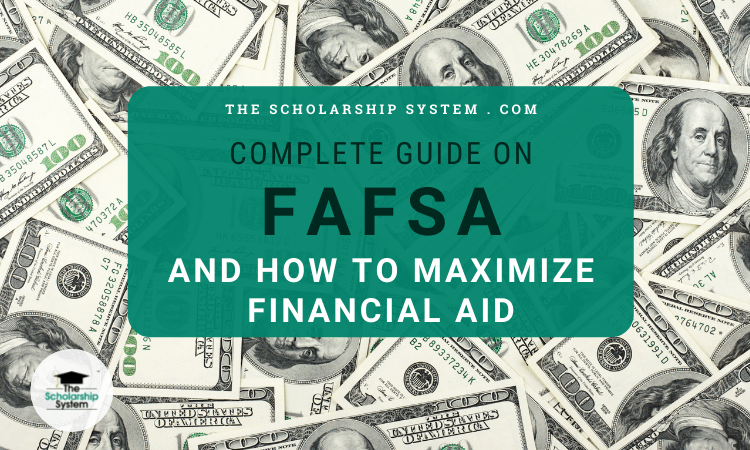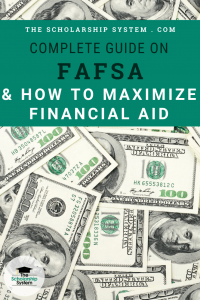Updated on May 20th, 2024
In the world of financial aid, the Federal Application for Federal Student Aid (FAFSA) is king. So, what is the FAFSA? It is a critical set of forms that determine whether a student is eligible for federal grants and loans, and is used by schools during the crafting of a student’s financial aid package.
If a student doesn’t submit their federal student aid FAFSA forms in a timely manner, they might miss out on free money. Why? Because certain kinds of funding are provided on a first-come, first-serve basis. That means, even if a student qualifies if their application isn’t received in time, the money could be gone.
Contents
- 1 How Does FAFSA Work?
- 2 How Do I Qualify for FAFSA?
- 3 How to Sign Up for FAFSA
- 4 What Do I Need to Fill Out the FAFSA?
- 5 How to Apply for FAFSA
- 6 How to Complete the FAFSA
- 7 When to Apply for FAFSA
- 8 How to Get the Most Financial Aid Through the FAFSA (Including Families with Young Students)
- 9 2019-2020 FAFSA CHANGES
- 10 2020-2021 FAFSA CHANGES
- 11 The 2021–22 FAFSA changes include the following:
- 12 Next Steps After FAFSA for a Debt-Free Degree
How Does FAFSA Work?
The FAFSA provides students with access to various funding sources based on specific eligibility requirements. This FAFSA walkthrough will help you determine what they look for in FAFSA eligibility, how you can secure FAFSA grants, and what not to do when submitting your FAFSA application. Watch the full video here: FAFSA Scholarship: Who It’s For, How To Apply & More
When a student submits an application, their expected family contribution (EFC) is calculated.
What is the EFC?
The Expected Family Contribute (EFC) is a dollar amount that is calculated after your student completes their FAFSA. It’s a reflection of what the system believes your family can afford and is used to determine your student’s eligibility for a variety of financial aid products, like grants and loans.
An EFC is determined based on data from four key areas: parental income and assets (with some exceptions below), and student income and assets.
Effectively, each area is used for one calculation on the FAFSA, and then the four results are reviewed together to make a determination.
If you want in-depth information on the EFC calculation, the US Department of Education’s Federal Student Aid Office has you covered. You can review the information here: The EFC Formula
Can You Get Federal Grants for College by Completing the FAFSA?
Yes, students can potentially gain access to federal grants by completing the FAFSA. Often, it is the most coveted form of financial aid.
Grants are considered free money (meaning you don’t have to pay it back!) that can be used for a range of educational expenses including tuition and books. For your student to receive a grant, you must meet certain criteria like falling below certain FAFSA income limits based on your family size.
Is FAFSA a Loan Since You Can Qualify for Federal Student Loans?
While the FAFSA can make a student eligible for federal student loans, the FAFSA itself is not a loan application. Instead, it determines whether students qualify for specific kinds of financial aid, including grants and loans.
Federal student loans are not free money, as they have to be paid back in accordance with your loan agreement. However, the interest rates are typically lower than the student loans you can find through traditional lenders, like banks and credit unions.
Federal student loans come in two forms: subsidized and unsubsidized. Subsidized loans offer better terms including:
- No interest while your student is enrolled in school at least half-time
- No interest during the six-month grace period after your student leaves school
- No interest during a period of deferment
Unsubsidized loans do not provide any of the “no interest” benefits offered by subsidized loans, making them more costly over the long term. While subsidized loans are need-based awards, families that do not qualify for grants can still often qualify for at least this type of loan which saves students tens of thousands of dollars. Unsubsidized loans can be available without having to demonstrate financial need.
The interest rates for subsidized and unsubsidized federal student loans are set by the government, so you don’t have to shop around to find the best deal. For loans disbursed between July 1, 2021, and July 1, 2022, the interest rates are 3.73 percent for direct subsidized loans for undergraduates and 3.73 for direct unsubsidized loans for undergraduates. These rates are subject to change for new loans issued after July 1, 2022, but this does not affect the interest rates on loans that have already been issued.
How Do I Qualify for FAFSA?
If you’re wondering who qualifies for FAFSA, the answer is practically everyone attending a college in the US, including citizens (usually anyone with a Social Security number) and eligible non-citizens.
FAFSA Qualifications
Here is a complete list of FAFSA eligibility requirements for federal student aid as set by the Department of Education:
- Be a citizen or eligible noncitizen of the United States.
- Have a valid Social Security Number. (Students from the Republic of the Marshall Islands, Federated States of Micronesia, and the Republic of Palau are exempt from this requirement.)
- Have a high school diploma or a General Education Development (GED) certificate, or have completed homeschooling. If you don’t, you may still be eligible for federal student aid if you were enrolled in college or career school prior to July 1, 2012. Go to https://studentaid.ed.gov/eligibility/basic-criteria for additional information.
- Be enrolled in an eligible program as a regular student seeking a degree or certificate.
- Maintain satisfactory academic progress.
- Not owe a refund on a federal student grant or be in default on a federal student loan.
- Register (or already be registered) with the Selective Service System, if you are a male and not currently on active duty in the U.S. Armed Forces. (Students from the Federated States of Micronesia, the Republic of the Marshall Islands, and the Republic of Palau are exempt from registering; see https://sss.gov for more information.)
- Not have a conviction for the possession or sale of illegal drugs for an offense that occurred while you were receiving federal student aid (such as grants, work-study, or loans). If you have such a conviction, you must complete the Student Aid Eligibility Worksheet to determine if you are eligible for aid or partially eligible for aid.
For specific kinds of federal financial aid, there can be additional requirements, such as falling within specific income limits. However, those are not a requirement for completing the FAFSA itself.
FAFSA Income Limits
There is no income limit for completing the FAFSA, so anyone who otherwise is eligible can (and should!) complete the application.
However, a student’s income (or their family income, if they are a dependent) may limit their access to specific kinds of aid, such as whether they can receive a Federal Pell Grant to help pay for college.
How to Sign Up for FAFSA
To sign up for the FAFSA, your student needs to either head over to https://studentaid.ed.gov/sa/fafsa or download the Android or iOS app, myStudentAid.
This gives your student access to the FAFSA forms, allowing them to apply for financial aid.
FSA ID
Ideally, your student should create a FSA ID before they complete their FAFSA for the first time. This is a unique username and password that allows them to sign their FAFSA electronically as well as access certain information online or through the app.
However, a FSA ID can also be created later in the process when they complete their first FSA. So, if they have already started on their application this year, they aren’t in a bad spot.
Parents also need to create FSA IDs if they want to sign any forms electronically. It’s important to note that parents must have a Social Security number to be eligible for an FSA ID.
What Do I Need to Fill Out the FAFSA?
To fill out the FAFSA properly, your student is going to need a lot of information. Plus, if they are a dependent, they don’t just need specific documents that cover their situation, but their parents as well.
Usually, students need the following to complete the FAFSA:
- Social Security Number(s)
- Driver’s License or Government-Issued ID Number
- Alien Registration Number (for non-US citizens)
- Federal Tax Returns and W-2s
- Bank Statements
- Investment Records
- Untaxed Income Records (child support, interest income, veterans non-education benefits, etc.)
With the right documents available, it takes around 30 minutes to complete the FAFSA first time. Each year after, the process tends to be quicker, as certain information can carry over from one year to the next.
How to Apply for FAFSA
Completing the FAFSA is a pretty easy process. It can be done online at: https://studentaid.ed.gov/sa/fafsa
Alternatively, there is also an app for Android and iOS called myStudentAid, that allows students to use mobile devices.
Once your student accesses the FAFSA, the process is incredibly straightforward. The application is broken into simple steps, ensuring that nothing important is overlooked.
Student Information
The first section your student will need to complete covers information about their identity, like their name, birth date, and Social Security number. But, if they already have an FSA ID, most of the information will be prepopulated, saving them a substantial amount of time.
In most cases, the questions in this section are very straightforward, so they shouldn’t run into too many difficulties here. However, there are a lot of them, so it can take a little time.
School Selection
Some students find the FAFSA form school selection page intimidating, particularly if they haven’t officially been accepted to a particular institution. But, what’s important to remember, is they can send their FAFSA details to any school, regardless of whether they have been accepted or even applied.
Worst case, it is wise to have your student add every school they are considering, as any college they don’t end up attending will securely discard the information. Plus, the schools can’t see where else your student sent their FAFSA, so there’s no risk there either.
Your student can add up to 10 schools at a time, and the handy search tool makes it a breeze as long as your student knows the state where the college is located and either the city or the school’s name.
Dependency Status
The dependency status section establishes whether your student needs to submit tax information for their parents on their FAFSA form or are considered an independent student based on guidelines set by Congress.
Most of the questions are incredibly simple, and your student only needs to select “yes” or “no” based on their current situation.
It’s important to note that your student’s dependency status for their FAFSA form may differ from that assigned by the IRS for tax purposes. That means the two may not match, so it’s best not to assume that their tax status automatically applies for their FAFSA.
Parent’s Demographics
The FAFSA form does contain demographic questions regarding the student’s parents (yes, that potentially means you), and they do have to be completed even if your student doesn’t live with their parents.
Again, the information is fairly basic, including items like names, birth dates, Social Security numbers (if applicable), and marital status.
An important note is that the student’s parents are determined based on legal status as guardians, so biological or adoptive parents, as well as legal guardians, may be classified as “parents” for the purpose of completing the FAFSA form. More information can be found here: Parents on FAFSA Form
If your student has special circumstances that prevents them from providing certain information, additional guidance can be found here: Special Circumstances Instructions
Financial Information
Generally, the financial information section is the one that causes people the most fear, but it isn’t as complicated as it seems.
First, the IRS Data Retrieval Tool, accessed through the “Link to IRS” button, can populate a lot of the information in just a few clicks, so it’s worth using if your student is eligible. They’ll just need to connect to the IRS system, providing details from the tax filing, check the “Transfer My Tax Information into the FAFSA form” box, and click “Transfer Now.” If successful, they’ll receive a confirmation message on the FAFSA site.
Otherwise, the information can be entered manually, referencing the tax return they should have on hand and any additional financial documents that may be required.
How to Complete the FAFSA
Once all of the information is recorded, it’s time to sign and submit their FAFSA form. That will complete the application process.
Sign and Submit the FAFSA Form
For independent students, they can do this on their own. However, dependent students also need their parents to sign the form to go through.
The electronic signature is based on the use of each person’s FSA ID. If your student completes their FAFSA in one sitting, they won’t have to provide their FSA ID details again to complete the process. Essentially, they can just click submit and send it on its way.
Parents will need to enter their FSA ID and identify as Parent 1 or Parent 2 in a drop-down menu, depending on how they were listed on the application.
Once everyone has electronically signed, your student should be all set, and their FAFSA will start processing. Your student can monitor the progress of their FAFSA by logging into fafsa.gov, and the schools they selected will automatically get the information, allowing them to use it to build financial aid packages if your student is selected for admission.
In the end, completing the FAFSA is actually pretty easy, and it’s definitely a must-do for every college student.
And remember, the FAFSA form must be completed EVERY YEAR, so make sure your student puts it on their schedule to get it handled when the next year’s application period opens.
When to Apply for FAFSA
Currently, you can begin submitting FAFSA applications on October 1 for the next school year. For example, October 1, 2019, was the first day for applications for the 2020-2021 school year.
Ideally, you want to complete the FAFSA as quickly as possible once applications are being accepted. Many awards are given on a first-come, first-serve basis, so getting in early can be incredibly beneficial.
What is the Deadline for FAFSA?
The federal FAFSA application deadline provides students with a TON of time to complete their FAFSA for each academic year. For example, for the 2021-2022 school year, students actually have from October 1, 2020 until June 30, 2022, to submit the FAFSA.
However, the federal deadline doesn’t completely answer this important question: When is FAFSA due?
While most people mistakenly assume that the federal deadline is the only one that matters, that simply isn’t true. States also have their own deadlines for certain financial awards and need your student’s FAFSA information on or before that date if they are going to be eligible. And these deadlines are all over the place.
For example, in Delaware, that deadline is April 15, 2021. In Idaho, for priority consideration, students need to submit their FAFSA by March 1, 2021.
Some states, like North Carolina, don’t have a specific FAFSA due date. Instead, they recommend completing the FAFSA as soon as possible after October 1, 2020, as they will award funds until they are gone, which can happen at any time.
Additionally, schools may also set their own FAFSA deadline, making it even more confusing. If your student wants to be considered for institutional awards through their college, then they need to submit their FAFSA’s before those dates.
Ideally, your student should take a moment and confirm deadlines set by both their state and school, and not just rely on the federal one.
What to Do if You Miss the School or State FAFSA Deadline?
If your student missed the state or school FAFSA deadline, all is not lost. It won’t necessarily affect their ability to be accepted, but it can mean they missed out on valuable aid funds.
However, it is important to have them finish their FAFSA as quickly as possible. Why? Because there could still be aid money out there. Often, the deadline establishes priority amongst applicants but, if all of the funds aren’t awarded, late applicants might get a second chance.
While it isn’t wise to count on funds being left over, as it is highly possible that won’t be the case, it does mean that the faster your student gets their hat tossed in the ring, the bigger the chance that it isn’t actually too late.
You can also reach out to your student’s financial aid office to see if they have any flexibility or funds left over. You may be pleasantly surprised by how helpful they can be.
How to Get the Most Financial Aid Through the FAFSA (Including Families with Young Students)
While it may seem as though you have little control regarding how these calculations unfold, the opposite is actually true.
There are strategies that allow you to maximize the FAFSA results, making it easier for your student to receive need-based awards.
Please note: We are not financial advisors and recommend running these by your certified financial planner, CPA, or another financial expert for verification.
Here are a few suggestions to get you started.
1. AVOID WITHDRAWING FROM RETIREMENT FUNDS
Distributions from Traditional IRAs and 401Ks are treated as taxable income by the FAFSA, which means your EFC will increase and your student’s eligibility for aid will decrease.
If you must use your retirement savings for any purpose, look into loans that are backed by your retirement account instead. Loans are not treated as income, so it won’t impact the FAFSA. Or you can make the withdrawal prior to the year that will be used for their FAFSA.
As a note, Roth IRA distributions are treated differently on the FAFSA, so the above rules don’t apply.
2. MAXIMIZE YOUR RETIREMENT SAVINGS
Home equity, retirement savings, and even some small businesses are typically excluded when it comes to FAFSA.
This means that traditional IRA and 401K contributions reduce the amount of income that is included in the FAFSA calculation, making it easier to get need-based aid. They are also tax-deductible, so maxing out your savings before the end of the tax year (December of your student’s sophomore year) can be beneficial.
3. TRANSFER YOUR STUDENT’S SAVINGS TO YOUR ACCOUNTS
Did you know that the FAFSA assesses your student’s assets at a higher rate than yours? Many parents don’t realize this, and the rate difference is substantial. This means that transferring your student’s savings into your account before their second semester of their junior year can result in a lower EFC, so it can be a wise move. If the money won’t be needed until later, some parents put the cash into a CD under their own name.
4. USE SAVINGS TO PAY DOWN DEBT
While having money in the bank is generally considered a good thing, it actually hurts your student when it comes time to file their FAFSA. While you don’t want to throw money out the window or spend it recklessly if you have debt, then using your savings to pay it down can be beneficial for two reasons. First, you reduce your debt load, letting you pay less interest over time. Second, it means the cash won’t play a role in determining your student’s EFC (typically increasing it).
Typically, you will first want to make sure that any savings you use is earning less interest in that account than you are paying on the debts you will pay down as this ensures you are getting the most value from the decision.
5. OPEN A 529 COLLEGE SAVINGS PLAN
Another option for lowering your EFC is to transfer some savings (yours or your student’s) into a 529 college savings plan. All assets in a 529 are calculated at the parental asset rate, and any distributions do not affect your student’s eligibility for financial aid.
6. MAKE MAJOR CASH PURCHASES BEFORE FILING THE FAFSA
If you have a major cash purchase on the horizon, complete it before your student completes their FAFSA. Again, this helps lower the amount of any savings you have, ensuring the funds aren’t part of the EFC calculation.
If the cash purchase is for your student’s education, and they have savings that can’t be transferred to your account, then consider having them spend their money first, since their assets are calculated at a higher rate.
7. DON’T LIMIT YOUR HOUSEHOLD TO ONE COLLEGE STUDENT AT A TIME
While the idea of two (or more) family members being in college simultaneously may seem intimidating, it actually helps when it comes time to file a FAFSA.
Why? Because the EFC applies to your entire family, not just the individual student. For example, if your EFC is $20,000 and you have two children in college, then half of that amount (or $10,000 apiece) is typically associated with each student in the eyes of the school. That means both of your children may cumulatively receive more in their financial aid packages than one of them would get if they are the only college student.
And, the two students don’t have to be siblings to fall under one EFC on the FAFSA! For example, if you went to college at the same time as your student, that counts too. So, if you were thinking of heading to school, it could be a great time to take the leap.
8. UNDERSTAND EFCS CHANGE EVERY YEAR
It’s important to note that your student’s EFC (Expected Family Contribution) will change every year based on their latest FAFSA information, so changes to income or savings levels can impact their financial aid throughout their college career.
That means, not only is it important to start planning for their first FAFSA, but it’s also important to make wise choices all the way through their final FAFSA filing. That way, your EFC can stay as low as possible, and you can help increase your student’s odds of graduating debt-free.
2019-2020 FAFSA CHANGES
For 2019-2020, FAFSA created a new tool to help ease the application process; a new mobile app called myStudentAid. The app is available for iOS and Android and helps give students and families access to the application on the go!
Not only is this app an option for applying for the FAFSA, but is a great resource for current college students to check their aid totals. Parents and students can also ‘chat’ within the app, keeping all your conversations about financial aid organized.
While you can apply for FAFSA using the app, we suggest that high school seniors and first-time FAFSA users use the traditional desktop version of the FAFSA to apply. It is important to fully understand each question, and the desktop version allows for a broader view of the application.
Finally, FAFSA rolled out a few interfaces changes on their website. If you are returning to apply for FAFSA again, you’ll notice that the home page has a new layout, designed to direct you to the correct FAFSA application. Within the forms, there is one color formatting change to be aware of. In the past, student and parent information have been highlighted in 2 different colors. Now, each page uses the same navy blue color. Be extra vigilant while you’re applying that you answer questions based on student and parent in the correct sections!
2020-2021 FAFSA CHANGES
This season, FAFSA, fortunately, kept changes minimal.
The 2021–22 FAFSA changes include the following:
- The income threshold for an automatic zero Expected Family Contribution (EFC) increased from $26,000 to $27,000 for the 2021–22 award year. You can learn more about EFC and how it’s calculated here.
- When students and parents use the IRS Data Retrieval Tool (DRT), the IRS DRT will now transfer information about whether they filed a Schedule 1 due to tax law changes. The answer will be based on all current exceptions for filing a Schedule 1. The transferred data for the Schedule 1 fields will be masked.
- For students and parents who don’t use the IRS DRT, the Schedule 1 help topics will be updated to include all current exceptions for filing a Schedule 1. “Capital Gains” has been removed as an exception and “Virtual Currency” has been added as an exception.
- Many FAFSA help topics referencing financial forms now feature images of those forms with relevant line numbers highlighted.
And remember, the FAFSA form must be completed EVERY YEAR, so make sure your child puts it on their schedule to get it handled when the next year’s application period opens.
Next Steps After FAFSA for a Debt-Free Degree
Once your FAFSA is completed, take a break… but not for too long. It’s time to apply for scholarships. Believe it or not, scholarship applications are open all-year-round, however, they begin as early as September for the following school year (yes, 12 months ahead of when the money will be used!)
If you want to learn our strategies on how to secure scholarships, including how I secured 6-figures in scholarships, join me for my next free online training at https://thescholarshipsystem.com/freewebinar.
You can also read more about the best time to apply for scholarships here: When Your Child Should Apply for Scholarships.
Lastly, you can also join our new FREE Facebook community, Debt-Free Degree Strategies, where you can ask questions about different strategies for a debt-free degree. We also periodically hold free trainings in the group. Request to join here: https://www.facebook.com/groups/PayingForCollegeStrategies. See you there!










Fantastic article on applying for FAFSA aid. The most difficult part for a majority of the applicants is filling out financial information in the FAFSA form. But you can directly link to the IRS Data Retrieval Tool (DRT), which automatically inputs the required tax information into the FAFSA form. It is the fastest and most accurate way to enter tax return information, without making any mistakes, increasing the chances of your application being accepted.
Great article! My wife and I have 2 young kids and the article does a great job spelling everything out. Such a great resource that I book marked it.